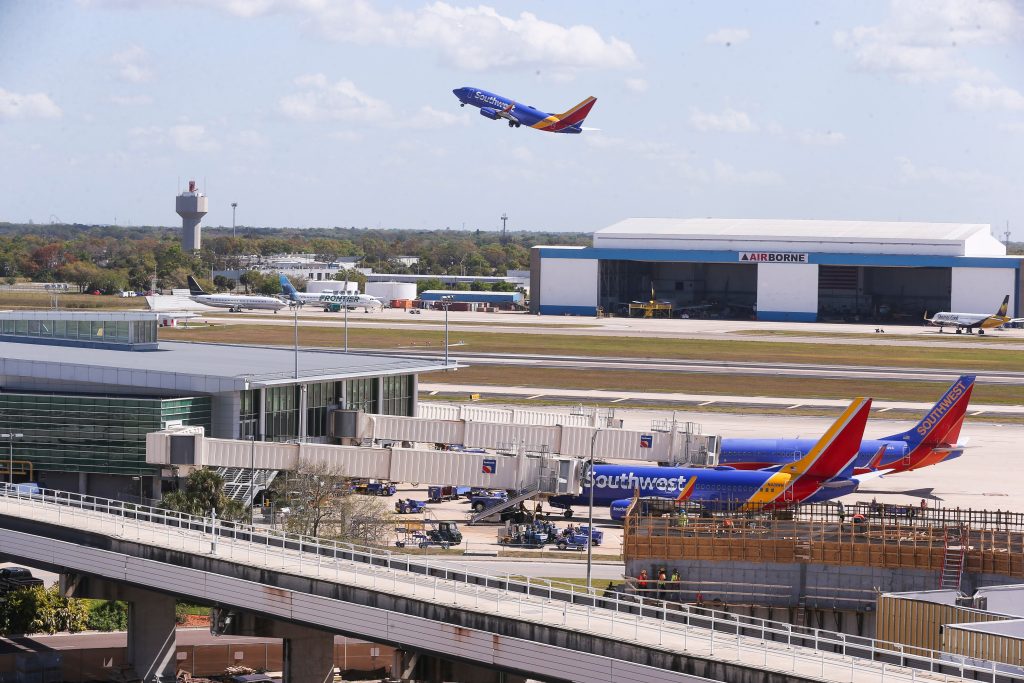On July 14, a Southwest Airlines plane bound for Tampa International Airport went into a nosedive, falling more than 1,500 feet in just over a minute and coming within 150 feet of the water in Tampa Bay.
Publicly available flight tracking data shows the plane was still several miles from its destination when the accident occurred just after 7 p.m., at which point it would have been more than 1,000 feet above the ground, according to Federal Aviation Administration flight charts.
Instead, it was flying at the height of a 15-story building.
The Boeing 737 MAX plane nosedived in stormy weather with light rain and wind gusts of up to 20 mph, according to the Tampa International Airport weather station. The weather was so bad that the flight, which had taken off from Columbus, Ohio, was rerouted to Fort Lauderdale.
According to a recording of the communication uploaded to YouTube, air traffic control warned the pilot that the plane was low altitude, at which point the plane rapidly climbed about 1,000 feet.
Veteran commercial pilot Robert Katz said the plane was flying so close to the ground that wind shear — a sudden change in wind speed and direction — could have “swatted the plane like a fly into Tampa Bay.”
Katz, a certified flight instructor in Texas, said the pilots did not appear to have monitored the plane’s descent and should have realized they were flying at a dangerous altitude without warning from air traffic controllers.
“This should never have happened,” Katz said. “The pilots will have a lot of explaining to do.”
He added that if conditions were bad enough that the plane needed to be rerouted, that decision should have been made long before the plane reached that point during its descent.
The FAA said in a statement that the incident was under investigation. A Tampa International Airport spokesman declined to comment and referred questions to Southwest Airlines.
“Southwest follows a robust safety management system and is in communication with the Federal Aviation Administration to identify and address any irregularities,” the airline said in a statement. “Nothing is more important to Southwest than the safety of our customers and employees.”
Ben Schlappig noted the dive on his flying blog. One Mile at a Timewrote Monday that the accident was a “near catastrophe.” He speculated that the pilot may have misidentified the Courtney Campbell Causeway, a long, straight road, as a runway and descended with the intention of landing.
Katz said that’s possible, but only if the pilot is extremely fatigued. He said such accidents often happen when pilots are stressed or fatigued and not paying attention, a situation that can be exacerbated by bad weather.
“There are a lot of indicators in the cockpit that the plane is going too low,” Katz said, “and a lot of checks and balances in place to get someone’s attention and wake them up and do something.”
Check out the top stories from Tampa Bay
Subscribe to the free DayStarter newsletter
We deliver the latest news and information you need to know every morning.
You’re signed up!
Want more of our free weekly newsletter delivered to your inbox? let’s start.
The flight follows a similar incident last month in Oklahoma City, where a Southwest Airlines jet was flying at an abnormally low altitude several miles from the airport.
In April, a Southwest Airlines plane went into a steep dive off the coast of Hawaii, coming within 400 feet of the ocean before beginning to climb.
The National Transportation Safety Board is also investigating a Southwest Airlines jet that suffered an unusual “Dutch roll” and found damage to its tail after a flight from Phoenix to Oakland, Calif. Investigators said the plane had been parked outside during a severe storm.
Times staff writers Leslie Cosme Torres and Shauna Mackle contributed to this report.


